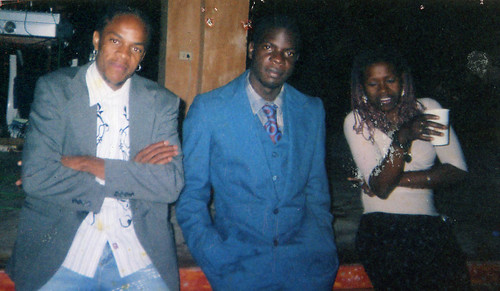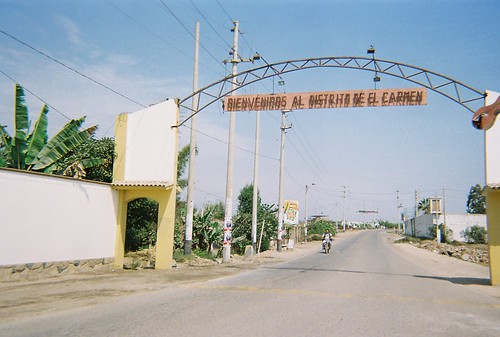Black Venezuelans (or Afro-Venezuelans) must be functioning in all areas of Venezuelan society; big business and all... Nice!
As I'm planning my trip to Venezuela this year, 2011, I could not help but to get very sarcastic with a Venezuelan I met on Thorntree, a travel site put up by Lonely Planet Publishing Company. This individual told me that there is no racism in Venezuela. I was a little incensed because I hear that from almost every person who comes from a Latin-American country. So far, the countries I've visited (seven) with a significant number of blacks, indigenous, and Asians, I noticed that these minorities are not so visible in shops, at airports, in office buildings; and not even in public transportation.
Juan, the only black journalist in his graduating class, never received a job offer like all of his other classmates.
I remember a good friend Juan, an Afro-Venezuelan, whom I met in Berkeley, CA who shared with me how everyone in his journalism graduating class in Venezuela got jobs. Juan, the only black in this graduating class, never received a job interview, let alone a job offer.
I told this Thorntree gentleman how I pleased I am to hear that there is no racism in his country. When I arrive, I'll be looking forward to seeing blacks in businesses, law enforcement, civil service, and other industries where blacks, indigenous, and Asians in the Latin-American countries I've visited are severely under-represented. And when I do see black Venezuelans and other minorities in all areas of Venezuelan society, I'm going to write my US government officials and tell them what we can learn from Venezuela.
To date, I've never heard a response from the gentleman who said there is no racism in Venezuela. However, on December 2011, I made it to Venezuela and was glad to see a greater black presence in different jobs, especially those working in immigration when I arrived at the airport. I even saw black business owners. And like other Latin-American countries, I saw plenty of interracial marriages and interracial children, especially between the blacks and the browns. However, I didn't see anything worth writing about in terms of no racism. An Afro-Venezuelan friend who herself is doing quite well stated bluntly that there is still racial discrimination in Venezuela.
This blog is about my exposure to the Spanish language and various Latin-American cultures through travel and research; particularly Black/Afro-Latino.
Friday, May 27, 2011
Thursday, May 26, 2011
Africa in Venezuela
As I plan my trips to explore black heritage in Latin-America, I chose Venezuela as one of the main countries to visit. For years, I've always wanted to visit Venezuela because I used joke around with Latinos telling them that I'm Venezuelan. I did that to send a subtle message that not all blacks who speak Spanish are from Cuba or Puerto Rico. I've been asked more than once if I'm from either of those two countries, especially by Mexicans and Mexican-Americans. I am self-taught in Spanish, and am still learning, but obviously my Spanish is impressive enough for some people to think I'm a native speaker.
Barlovento eventually became one of the many runaway-slave settlements called a cimarrón.
Most of my time in Venezuela will be spent in the predominately black region of Barlovento. The Barlovento region is west of Caracas, the nation's capital, in the state of Miranda going towards the Caribbean Sea.
Barlovento is famous for its cacao and is considered to be among the best in the world. During the Trans-Atlantic slave trade, the Spanish imported slaves from Africa to work on cacao plantations, from which cocoa, cocoa butter, and chocolate are made and exported to Europe creating wealth for the slave masters. Barlovento eventually became one of the many runaway-slave settlements called a cimarrón. By the time slavery was abolished in the 1820s, a significant number of free black folks were settled in Barlovento. Most of these ex-slaves and descendants of these ex-slaves continued the legacy of cacao production in the region.

The Barlovento Region of Venezuela
Like Nat Turner in the U.S., Yanga in Mexico, Bioho in Colombia, and Illescas in Ecuador, rebel slave leaders rose in Venezuela as well. The most famous uprising occurred in 1552 when the rebellion was led by El Negro Miguel who raised a military force of 1,500 slaves to attack Spanish settlements. Rebel slave communities continued to grow throughout the 1600s, and by the year 1720, there were up to 30,000 cimarrones (escapred slaves) in Venezuela, compared to those 60,000 still serving their masters.
Just as in other parts of the Americas, cimarrones (runaway slaves) were often assisted by indigenous peoples as they conducted raids on plantations, freeing the slaves and trading contraband. The town of Curiepe in Barlovento was the only legally established town of free Blacks. Curiepe was made up of former members of Caracas's Company of Free Blacks as well as escaped slaves from non-Spanish-speaking islands who were given their freedom in Venezuela, only under the condition that they get baptized.

Every year, June 24, Afro-Venezuelans Celebrate Día de San Juan (St, John's Day) with drumming and dance.
Black Venezuelans played a decisive role in their country's War of Independence. South American liberator Simón Bolívar thoroughly understood the strategic importance of black soldiers and abolished slavery in 1812 and again in 1816. Bolívar being a slave master himself freed 1,000 of his own slaves, and recruited 5,000 slaves into his army. One of Bolivar's most famous lieutenants, Pedro Camejo, is known in Venezuela's history books as "El Negro Primero (The First Black)," because he was always the first to ride into battle.
A statue of El Negro Primero today stands in the Plaza Carabobo in Caracas—the only statue commemorating a Black in all Venezuela. Throughout the War of Independence, Venezuela, slavery continued to decline. By 1821, a new law was on the books declaring all black newborns as free. And by 1854, slavery in Venezuela was completely abolished. Still blacks endured racial discrimination despite a government philosophy that all racial groups blend together. I've met non-black Venezuelans who believe that all Venezuelans are one and that there is no racism.
However every year, public festivals such as the Fiesta de San Juan (June 24) celebrate pride in Afro-Venezuelan culture making bold statements in their resistance to the dominant culture and consciousness of being a marginal community.
African Music in Venezuela
Tuesday, May 17, 2011
La Bamba: Souls of Black Mexican Folks
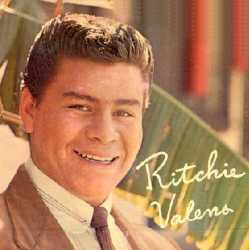
RITCHIE VALENSFamous for the top 40 hit song “La Bamba” 1958
Souls of Black Mexican Folks
In 1958, Mexican-American rock musician Ritchie Valens of Pacoima, CA released the famous tune “La Bamba” on Del-Fi Records. The single became a top-40 hit in the U.S., and was named number 345 in Rolling Stone magazine’s list of the 500 greatest songs of all time. “La Bamba” is the only song on the list not sung in English. “La Bamba” is originally a traditional folksong and dance of the musical genre called Jarocho. It is well documented that Jarocho music is connected to the African continent. Bamba, or the Mbamba, is an ethnic group in the Bamba district along the Bamba River of the Congo and Angola, West Africa. La Bamba was first sung by slaves brought to Mexico by the Spanish as they worked in the fields and mines of Vera Cruz, Mexico as early as 1683.
Slaves in Mexico came primarily from the
Kongo and Angola regions of West Africa.
There have been no official figures on the numbers of Mexicans of African descent since 1810, when a census found that black people made up 10 per cent of the total population. Mexicans of African descent were vital to the early economic growth of Mexico, working in urban professions, developing and cultivating farmland, providing skilled labor in the silver mines, and working on cattle ranches and sugar plantations. African influence in Mexico can also be seen in the many cultural traditions of that country. However, after more than 500 years interracial marriages and relationships, the black population in Mexico has dwindled considerably.
After more than 500 years interracial marriages and relationships, the identifiable black population in Mexico has dwindled considerably.
Several organizations have also emerged to reclaim Afro-Mexican traditions, for example the annual Encounter of Black Populations, which started over ten years ago, and Black Mexico, an organization dedicated to fighting for the cultural and political rights of people of African descent in Mexico. These organizations have been in increased dialogue with other Afro-Latin Americans throughout the region. Since 2004, there have been a number of photography exhibits, film series and forums on Afro-Mexicans throughout the US. In Veracruz there has been a resurgence of African-influenced Son Jarocho music, which has also helped to bring visibility to these issues. Although in many parts of Mexico, many people of African ancestry still do not identify themselves as such, the increased migration of Afro-Mexicans to other parts of the country and to the US has significantly impacted on this population’s consciousness of its African roots.
Related Posts
La Bamba” and It's African Roots
Mexico's “Dark” Secret: The Black La RazaThe Soul of Mexican Independence
Monday, May 16, 2011
A Foreign Women Loves Me; Loves Me Not!
I met Juana María (not her real name) on Facebook months before my 2010 trip to Perú. A separate Spanish-speaking Facebook account has already been opened in order to meet people in Latin-American countries that I planed to visit, preferably Afro-Latinos. A female is a plus. My primary motive for making Facebook friends in Latin-America is to have strong social connections to make my trips more personable and enjoyable. This worked nicely in Venezuela and Colombia, and very nicely in Perú and Ecuador. And to this day, this practice is still working for future trips.
I wonder if Juana would have had the same interest in me if I were from the community. Is she interested in me or where I'm from?
When Juana's name and photo came up on my Facebook page as a friend suggestion, I looked over the available information in her profile and saw that she is from Chincha, Perú; my home away from home where I've been traveling since 2005 and established close ties with people in the community. I immediately sent her a friendship request. She responded with a personal e-mail in over-anxious attempts to get to know me. Almost daily, she would look me up on Facebook to see if I was on line to initiate conversations.
We both learned that she and I knew the same people in and around Chincha. I asked my Facebook friends in Chincha, Perú about Juana María, one of whom, confirmed my suspicions. His exact words translated into English were, “she would love to have a wealthy, classy man like you (a lot of people in third-world countries think all Americans are in the same income bracket as Donald Trump).” A local doctor warned me that she likes to take advantage of foreigners. None of this surprised me, for with my travel experience and even here in the US, I've been approached by women from The Philippines, Cuba, India, Nigeria, Nicaragua, Mexico, and Ethiopia with only one thing in mind---obtaining a resident alien card to live in the US.
I've been approached by women from The Philippines, Cuba, India, Nigeria, Nicaragua, Mexico, and Ethiopia with only one thing in mind.
However, I took all of my Facebook friend's comments with a grain of salt. After all, I was not in Perú to find a woman, I was in Perú to immerse myself in the Spanish language and the culture, particularly black culture. I even took Juana and her 14-year-old son out to a popular Peruvian soul food restaurant called Mamainé. On another occasion, I rented a van and took her, her son, and 15 others to the beach, and after wards, to a restaurant for a roasted chicken dinner. Juana María stayed close by me throughout the day, and even gave me that extended gaze of interest. I continued to maintain the “friend-ship.” My heart was focused on everyone having a good time.
I wonder if Juana would have had the same interest in me if I were from her community. Would she even notice the content of my character or would she even care? Is she interested in me or is she interested in where I'm from? Juana María is a good-looking woman, why hasn't she already found her prince? As much as I like to travel, will I ever be open to bringing home a wife? Who knows! However, I see nothing wrong with finding someone where there is a mutual attraction, mutual interests, and complementary characters right here in the USA.
I wonder if Juana would have had the same interest in me if I were from the community. Is she interested in me or where I'm from?
When Juana's name and photo came up on my Facebook page as a friend suggestion, I looked over the available information in her profile and saw that she is from Chincha, Perú; my home away from home where I've been traveling since 2005 and established close ties with people in the community. I immediately sent her a friendship request. She responded with a personal e-mail in over-anxious attempts to get to know me. Almost daily, she would look me up on Facebook to see if I was on line to initiate conversations.
We both learned that she and I knew the same people in and around Chincha. I asked my Facebook friends in Chincha, Perú about Juana María, one of whom, confirmed my suspicions. His exact words translated into English were, “she would love to have a wealthy, classy man like you (a lot of people in third-world countries think all Americans are in the same income bracket as Donald Trump).” A local doctor warned me that she likes to take advantage of foreigners. None of this surprised me, for with my travel experience and even here in the US, I've been approached by women from The Philippines, Cuba, India, Nigeria, Nicaragua, Mexico, and Ethiopia with only one thing in mind---obtaining a resident alien card to live in the US.
I've been approached by women from The Philippines, Cuba, India, Nigeria, Nicaragua, Mexico, and Ethiopia with only one thing in mind.
However, I took all of my Facebook friend's comments with a grain of salt. After all, I was not in Perú to find a woman, I was in Perú to immerse myself in the Spanish language and the culture, particularly black culture. I even took Juana and her 14-year-old son out to a popular Peruvian soul food restaurant called Mamainé. On another occasion, I rented a van and took her, her son, and 15 others to the beach, and after wards, to a restaurant for a roasted chicken dinner. Juana María stayed close by me throughout the day, and even gave me that extended gaze of interest. I continued to maintain the “friend-ship.” My heart was focused on everyone having a good time.
I wonder if Juana would have had the same interest in me if I were from her community. Would she even notice the content of my character or would she even care? Is she interested in me or is she interested in where I'm from? Juana María is a good-looking woman, why hasn't she already found her prince? As much as I like to travel, will I ever be open to bringing home a wife? Who knows! However, I see nothing wrong with finding someone where there is a mutual attraction, mutual interests, and complementary characters right here in the USA.
Friday, May 13, 2011
What Do Spanish-Speakers Look Like?
Nearly 1,400 readers visited this site, and no one has yet been able to give an intelligent answer to my question—what do Spanish speakers look like? Can you? Don't let me grow old waiting!
One morning, I stopped in a Walgreens store in San Francisco to buy a Latin-American phone card. The woman at the checkout counter, without bothering to ask if I speak Spanish, suggested that I buy a calling card for English speakers. This is far from the first time someone ASS-umed that I did not speak Spanish. Annoyed, I told her (in Spanish) that I have friends in Latin-America who speak Spanish only and I need this particular card! She acknowledged what I said by mumbling something about San Francisco being a multicultural city. Yeah, whatever!
I pointed this experience out to some friends, and humbly asked for some enlightenment; how do you look at someone and determine what language they can or cannot speak? A former college classmate answered,“ just ignore them Bill. She was just plain stereotyping. I'm sure when you responded in Spanish she felt silly.”
Another friend, who unlike I, happens to be a black native Spanish-speaker (half Cuban and half Dominican) says she has pity on people like that; she slams them with her Spanish, and the near look of cardiac arrest gives her great satisfaction.
From my growing up near Spanish Harlem in New York City, and working in Latino communities in Oakland and San Francisco, I know plenty of people, white, brown, and black who are of Latin-American ancestry who know little or no Spanish. Yet, I've met people of Chinese, Lebanese, and Jewish ancestries who are “native Spanish-speakers.” The same paradox goes for other languages.
When are people going to wake up and understand that you cannot simply look at people and discern their first, second, or third language?
Former Miss Ecuador - Mónica Chalá
One morning, I stopped in a Walgreens store in San Francisco to buy a Latin-American phone card. The woman at the checkout counter, without bothering to ask if I speak Spanish, suggested that I buy a calling card for English speakers. This is far from the first time someone ASS-umed that I did not speak Spanish. Annoyed, I told her (in Spanish) that I have friends in Latin-America who speak Spanish only and I need this particular card! She acknowledged what I said by mumbling something about San Francisco being a multicultural city. Yeah, whatever!
I pointed this experience out to some friends, and humbly asked for some enlightenment; how do you look at someone and determine what language they can or cannot speak? A former college classmate answered,“ just ignore them Bill. She was just plain stereotyping. I'm sure when you responded in Spanish she felt silly.”
Another friend, who unlike I, happens to be a black native Spanish-speaker (half Cuban and half Dominican) says she has pity on people like that; she slams them with her Spanish, and the near look of cardiac arrest gives her great satisfaction.
From my growing up near Spanish Harlem in New York City, and working in Latino communities in Oakland and San Francisco, I know plenty of people, white, brown, and black who are of Latin-American ancestry who know little or no Spanish. Yet, I've met people of Chinese, Lebanese, and Jewish ancestries who are “native Spanish-speakers.” The same paradox goes for other languages.
When are people going to wake up and understand that you cannot simply look at people and discern their first, second, or third language?
Wednesday, May 11, 2011
PBS Series: Black in Latin-America

I was just watching the TV series Black in Latin-America. Of all the things that were discussed in this series, I've been blogging about for more than one year. People are beginning to wake up to the fact that more blacks went to Latin-American countries, including Mexico, Argentina, and Perú than to the United States of America. What is even more pleasant is that more and more African-Americans are also waking up for too many of us seem to feel that we African-Americans are the only legitimate blacks in the African diaspora.
What surprises me more than anything is that so many Latinos I meet are unaware of the African presence in their own countries. The TV host, Professor Louis Henry Gates Jr., said it well, Latinos have black abuela (grandmother) in the closet.
On a couple of occasions, I had to explain to some young Mexican-Americans, who thought it was so humorous that a black person (referring to me) is speaking Spanish that there are over 150 million Spanish-speakers who are black, not to mention the millions of others who have African blood, like Fulgencio Batista, former president of Cuba, and Vicente Guerrero, Mexico's liberator and second president.
Personally, I celebrate Black Heritage in Latin American countries because I'm so moved by the variety of music where African people had an influence, music like cumbia (Colombia), salsa (New York City), merengue (Dominican Republic), bachata (Dominican Republic), fandango and jaraocho (Mexico), festejo, landó, and zamacueca, Perú, cueca (Chile), and son-montuno (Cuba).
Saturday, May 7, 2011
Peruvians in the Hood
My First Encounter with the Black Peruvian Population
When I used to think of the hood, I used to think of poor or working class black (and brown) communities around the United States such as Harlem in New York City, East Oakland, California, or the Fifth Ward of Houston, Texas. No longer do I restrict this perception to the United States of America. There are hoods in Paris, London, and Mexico (yes, Mexico; see my post entitled Mexico's Dark Secret). However, one of the most enjoyed hoods I've ever visited is El Carmen in Chincha, Perú.
Unlike your average hood in the USA, crime is next to zero in El Carmen despite the poverty. Well, at least according to my perception. Almost everyone is mellow in their relationship with each other and with visitors. I've exchanged many greetings with total strangers as we passed each other on the street. During my visits to El Carmen over the last five years, I've never seen or heard any conflicts among the residents, or observed any drama. When they party, they party hearty without any trouble makers spoiling the fun.
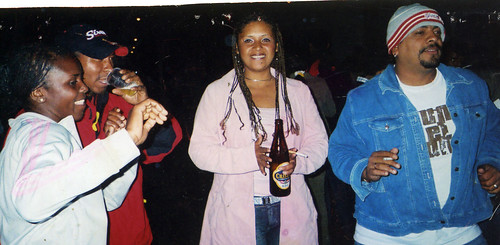
A block party in El Carmen, Perú
I first came in contact with this community in the Spring of 2005, thanks to Moons Travel Guide, which contained the address and phone number of the late Amador Ballumbrosio who played a large role in reviving and popularizing Afro-Peruvian music and dance. Almost everyone in his family are either dancers, musicians, or both. With my wanting to be totally immersed in the Spanish language and wanting to explore black cultures in Latin-American countries, I called the home of the Ballumbrosio family. The woman who answered the phone was Maribel, Amador's daughter. Her demeanor over the phone was one of a long, lost relative inviting me home. We agreed on a very inexpensive price of my stay, plus meals.
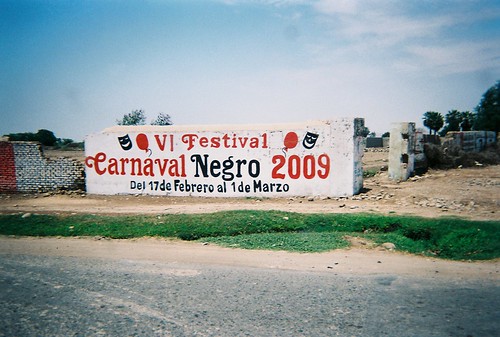
a Black Heritage celebration with music and dance
I arrived in El Carmen at 4:00 AM, not realizing that the family left their door unlocked for me. My cab driver then took me to the local police station where an arrangement was made for me to spend a night at the local hotel for one-half price (13 nueva soles, approximately $4.00 USD). At the station, there seemed to be only one police officer on duty, and he was wrapped in a blanket trying to stay awake for he had nothing to do. The town of El Carmen is that cool; tranquilo, as people call it.
When I arrived at the Ballumbrosio home at 10 AM the next morning, I was greeted with hugs. What I enjoyed most about this community is that it is off the beaten path--no tourists. The few tourists who do come never stay long. There is very little here to offer tourists except music and dance performances in the living room of the Ballumbrosio home, and of course, during the month of February when they celebrate black heritage with music and dance. People from all over Perú, and different parts of the world converge on El Carmen with the slogan, “Vamos Pa' Chincha, Familia, meaning Let's Go To Chincha, Brothers and Sisters (El Carmen is in the province of Chincha).
Because I do not care for crowds and constant noise, I avoid going to Perú in the month of February. In fact, all of my travels is during the “slow season.” I enjoy the tranquility of El Carmen outside the month of February. During my first trip, I was always invited to some party or a social event on the weekends. I never had to go anywhere for entertainment. Everything was right there in the hood. Unfortunately, a major earthquake came along in 2007, destroying much of El Carmen's infrastructure. Today, it's just not the same. Many of the people I met left. But I still love the people, the energy, and the environment. It's my home away from home.
Monday, May 2, 2011
Racism in Cuba Bounces Back
...or Did It Ever Go Away?
 In my 1998 trip to Cuba, I had on language and cultural blinders; unable to see the real Cuba that has been driving so many citizens away since Castro took office. An overwhelming majority of these citizens were white. By the time I arrived in Cuba, more black Cubans were fleeing the island, like my personal friend, Vladimir, who risked his life on a raft made of inner-tubes. I was only interested in improving my Spanish, developing my salsa dancing skills, and learning about Afro-Cuban history and culture.
In my 1998 trip to Cuba, I had on language and cultural blinders; unable to see the real Cuba that has been driving so many citizens away since Castro took office. An overwhelming majority of these citizens were white. By the time I arrived in Cuba, more black Cubans were fleeing the island, like my personal friend, Vladimir, who risked his life on a raft made of inner-tubes. I was only interested in improving my Spanish, developing my salsa dancing skills, and learning about Afro-Cuban history and culture.I felt very much at home with the black presence almost everywhere; on campus, in shops, at the airport, in taxis, not to mention the black doctors and engineers. In fact the first black astronaut in the world is Afro-Cuban. However, my time spent in Cuba was not enough time to experience the racial frustrations of Afro-Cubans. People were generally nice to me, primarily because I'm a gringo, who perceptibly had a lot of money to circulate in their economy.

Cuban civil-rights leader Oscar Biscet is serving a 25-year sentence in a maximum security prison for trying to follow the path of Martin Luther King.
When Fidel Castro took office in 1959, he issued anti-discrimination laws and declared the end of racism and discrimination. I was always wondering why an overwhelming number of white Cubans were fleeing the Castro regime during the 1960s and 1970s, and not too many of the blacks. Perhaps, this had a lot to do with opportunities being opened to black Cubans that were not open to them before. Even though black Cubans have made great advances under the Fidel Castro's regime (blacks in no other Latin American country comes close), many young Cubans contend that a form of structural racism exists, and that it is getting worse. In the tourist industry, which is growing by leaps and bounds while the rest of the Cuban economy languishes, blacks are underrepresented in the big new five-star hotels and the ancillary services springing up, such as waitresses, doormen, tour guides and cab drivers. Organizations like the NAACP are not allowed in Cuba. Dr. Oscar E. Biscet, President of the Lawton Foundation for Human Rights, attempted to follow the path of Martin Luther King and is currently serving a 25-year sentence at a maximum security prison.

In the film Inventos, black Cuban hip-hop artists speak out against racism and unemployment.
In music, young Cuban songwriters slip in sly lyrics about skin color, unemployment and racism. At a recent performance by the popular group NG La Banda, for example, the singer added a line about a black man being stopped by police on the street. That is the one concrete, on-the-ground issue that almost all black Cuban men, especially young men, can relate to: being halted by police and made to produce their documents. There was a case of a black man who went to a party where there were a number of black couples. When he told his story of being stopped in Havana while an identically dressed white man was allowed to breeze by, and how he demanded to know why he was singled out, the cop said police were looking for someone with physical characteristics like his. Everyone laughed because four or five black men there had experienced the same thing, and were also told, “we are looking for someone with physical characteristics like yours.” The black man who told the story went on to add that if the cops are going to lie, they should at least be original!
Subscribe to:
Posts (Atom)






